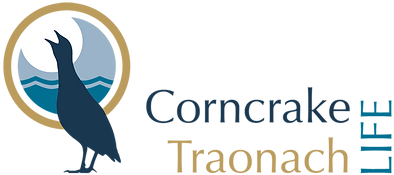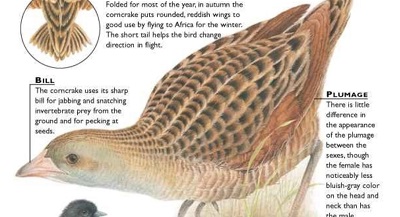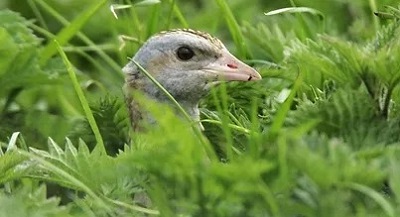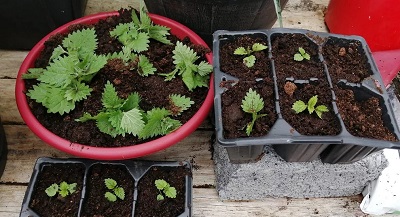


Fáilte a chairde! Corncrake/Traonach LIFE Project as part of its community engagement strategy have designed a schools educational programme to complement and support the work of the project goals. It aims to educate primary school children from 3rd to 6th Class on the Corncrake, its ecology and its value as an asset to the community. The model of delivery will include emphasis on existing Science, Technology, Engineering, Arts and Mathematics (STEAM) subjects and incorporating delivery of these into the school curriculum. It is a developmental programme which incorporates different styles of learning. Delivery style includes a blend of information sharing, indoor and outdoor activities to raise awareness of the Corncrake, the impact of farming practice, and highlight the power and capability that each individual holds to positively affect their environment and wildlife.
The CorncrakeLIFE Schools programme connects young people with local nature and empowers them to protect their natural world now and into the future.
Research has shown that there is significant correlation between children’s connection to nature and nature near their homes. Field trips to local Corncrake habitats or other habitats aim to focus the children on the abundance of wildlife and nature in their locality.
To deliver a primary schools programme on the topic of Corncrake conservation. The programme contains three sessions (ideally starting March) including a field trip if possible during the third session (ideally May/June)
Time required per session is approximately 90 minutes.
Materials Required:
Resources:
- Seed trays, Compost and Potting trowel, Watering can
- Seeds e.g. Common hogweed, Wild Parsley, Oats, Kale
- Gloves if required
- Scissors to cut out the birds life stages and plants in Corncrake life cycle.
- Blu tac, Post its, Flipcharts and Markers
- Clip boards for field trip and scavenger hunt
- Magnifying glass, Field Glasses, Telescope (all optional)
Actions / Programme Outline:
Following an introductory email and information sheet (or personal visit where feasible) of the project staff to the schools. (Appendix 1)
Three Classroom based sessions / activities commence:
Follow the links in the section below to access the information for each of the sessions.
Session 1: Educational Material
Icebreaker: (10mins)
e.g. Fruit salad – move if you’re a…./ like Pizza….
What food does the child beside you like…, hobbies etc
Introduction to the Corncrake and CorncrakeLIFE: (10mins)
Short PowerPoint presentation on status, population, range of bird with supporting materials, leaflet and display, use of props – bird, egg etc.) Appendix 2
Baseline Questionnaire: (10 mins) for participants to establish their current connection with nature. This baseline score will be revisited at the end of the programme to assess the impact of the programme. (Appendix 3)
This questionnaire will feedback on the programme effectiveness and influence the development of positively held attitudes and beliefs towards nature. When young people are connected to nature it has beneficial impacts on their education, physical health and emotional wellbeing. It also improves their social skills and helps them become responsible citizens.
Ecology: (5mins)
Diet, breeding cycle, favoured habitat.
Lifecycle Activity: (groups of 3/4) (20mins)
Children will be given A3 size card with months of the year shown and be invited to cut out the various stages of a Corncrake’s lifecycle and stick on correlating months. (Appendix 4)
Farming Practice: (10 Mins)
Discussion around farming practice – mowing/grazing times.
Invite children to overlay the lifecycle timeline with mowing times using cut outs
Slide to show overlap of Corncrake lifecycle and grazing/mowing practices
Wildlife Friendly Mowing (WFM) Activity: (20 mins)
Slide 13 of presentation (Appendix 2)
Children invited to discuss and demonstrate on provided sheets how birds and other wildlife may be protected during mowing of meadows. (Appendix 5)
Information on Habitat:
Wildflower slides. Slide 16-19
Discussion around a healthy habitat and its functions: provides protection, shelter, food and nest sites for corncrake
Good habitat also protects water quality and encourages other birds and insects e.g. Great Yellow Bumble Bee
Activity:
Prepare and sow seed trays.
Instruction on propagation.
Wildflowers and Seed Collection:
Further information on habitat and an invitation for participants to become “Cairde na dTraonach” by collecting specific seeds as demonstrated.
More information on Cairde na dTraonach can be found on www.corncrakeLIFE.ie
Slides 20-28
Close:
Would anyone like to suggest what you would like to do for next session?
More of…., Less of…. What I enjoyed… What I would change…..
Optional
Task for children between first and second session… design a poster…
Appendices for Session 1
- APPENDIX 1 – CorncrakeLIFE-Schools-Programme-Lesson-plan.
- APPENDIX 2 – Powerpoint slides for 1st Session CorncrakeLife
- APPENDIX 3 – Baseline Questionnaire for connectedness to nature Corncrake Lifecycle Timeline A3 (cut outs to paste)
- APPENDIX 4 – Timeline
- APPENDIX 4A – Cut-outs birds, tractors
- APPENDIX 4B – Timeline cut-outs plants
Session 2:
Icebreaker: (10mins)
Introduction and recap: (10mins) on first visit especially for any student who was absent.
Check on seed trays with children and make any suggestions necessary to improve germination of plants.
Explore what they have being doing and what they discovered about the corncrake since last session.
Activity Sheet: (15 mins)
Word search and maze etc. (Appendix 7)
Corncrake Predators:
Write down what you think may be a predator. Slide 11-12 (Appendix 6)
Migration:
Brainstorm with participants – why migrate and how?
Power Point Presentation: Migration, Ecology, Predators and STEAM (Appendix 6)
Corncrake Quiz: (20 mins)
Designed to be interactive using kahoot – children can work alone or in teams.
Revision of all information shared so far. (Appendix 8)
Also possible to do quiz on paper.
Feedback and close
Optional activity
Demonstration of bird song and information on other birds found in the area.
Appendices for 2nd Session
- APPENDIX 6 – Power Point Presentation Slides for Programme 2nd Session
(Ecology, Predators, STEAM and Migration) - APPENDIX 7 – Corncrake themed Word Search and Maze
- APPENDIX 8 – Corncrake Quiz (Kahoots or Paper based)
Session 3: (Field trip to CorncrakeLIFE Project participants)
Hire of minibus or mini coach or supervised walk in group if local site
Confirm School insurance cover for this activity
Transport of seed trays and spades/trowels
Plant the seeds propagated since session 1 with the permission of landowner
Scavenger hunt for wildflowers using a handout and information provided (appendix 9A 9B)
Input from CorncrakeLIFE Field Officers if available: Guided walk, flower and plant identification, soil classification, bird song recording.
Feedback from group and teachers (Appendix 10)
Complete Baseline quiz (2nd time) (Appendix 3)
Present a badge and Corncrake Champion Certificate to each child. (Appendix 11)
Picnic – (children’s lunchbreak in outdoor setting e.g. water/fruit juice and cereal bar)
Photo opportunity if permission obtained
Appendices for Session 3
- APPENDIX 9A – Scavenger Hunt sheet
- APPENDIX 9B – Scavenger Hunt Wildflower Species information
- APPENDIX 10 – Teacher Feed Back form
- APPENDIX 11 – Corncrake Champion Certificate
- APPENDIX 12 – Events Training Attendance Form
- APPENDIX 3 – Baseline Questionnaire for connectedness to nature Corncrake Lifecycle Timeline A3 (cut outs to paste)
Closure of Schools Programme:
Have students briefly summarise their learning
Document student’s feedback
Implement Continuous Improvement Model for Programme



